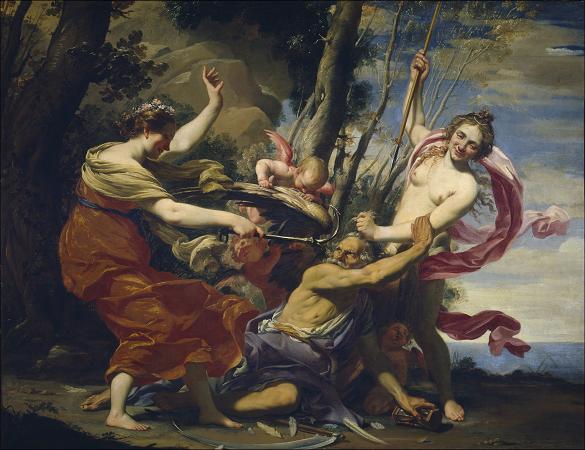Hope (1886). Oil on canvas. 142 x 112. Hope is a Symbolist oil painting by the English painter George Frederic Watts, who completed the first two versions in 1886. Radically different from previous treatments of the subject, it shows a lone blindfolded female figure sitting on a globe, playing a lyre that has only a single string remaining. The background is almost blank, its only visible feature a single star. Watts intentionally used symbolism not traditionally associated with hope to make the painting's meaning ambiguous. While his use of colour in Hope was greatly admired, at the time of its exhibition many critics disliked the painting. Hope proved popular with the Aesthetic Movement, who considered beauty the primary purpose of art and were unconcerned by the ambiguity of its message. Reproductions in platinotype, and later cheap carbon prints, soon began to be sold. Although Watts received many offers to buy the painting, he had agreed to donate his most important works to the nation and felt it would be inappropriate not to include Hope. Consequently, later in 1886 Watts and his assistant Cecil Schott painted a second version. On its completion Watts sold the original and donated the copy to the South Kensington Museum; thus, this second version is better known than the original. He painted at least two further versions for private sale. As cheap reproductions of Hope, and from 1908 high-quality prints, began to circulate in large quantities, it became a widely popular image. President Theodore Roosevelt displayed a copy at his Sagamore Hill home in New York; reproductions circulated worldwide; and a 1922 film depicted Watts's creation of the painting and an imagined story behind it. By this time Hope was coming to seem outdated and sentimental, and Watts was rapidly falling out of fashion. In 1938 the Tate Gallery ceased to keep their collection of Watts's works on permanent display. Despite the decline in Watts's popularity, Hope remained influential. Martin Luther King Jr. based a 1959 sermon, now known as Shattered Dreams, on the theme of the painting, as did Jeremiah Wright in Chicago in 1990. Among the congregation for the latter was the young Barack Obama, who was deeply moved. Obama took The Audacity of Hope as the theme of his 2004 Democratic National Convention keynote address, and as the title of his 2006 book; he based his successful 2008 presidential campaign around the theme of Hope. George Frederic Watts was born in London in 1817, the son of a musical instrument manufacturer. His two brothers died in 1823 and his mother in 1826, giving Watts an obsession with death throughout his life. Meanwhile, his father's strict evangelical Christianity led to both a deep knowledge of the Bible and a strong dislike of organised religion. Watts was apprenticed as a sculptor at the age of 10, and six years later was proficient enough as an artist to earn a living as a portrait painter and cricket illustrator. Aged 18 he gained admission to the Royal Academy schools, although he disliked their methods and his attendance was intermittent. In 1837 Watts was commissioned by Greek shipping magnate Alexander Constantine Ionides to copy a portrait of his father by Samuel Lane; Ionides preferred Watts's version to the original and immediately commissioned two more paintings from him, allowing Watts to devote himself full-time to painting. In 1843 he travelled to Italy where he remained for four years. On his return to London he suffered from depression and painted a number of notably gloomy works. His skills were widely celebrated, and in 1856 he decided to devote himself to portrait painting. His portraits were extremely highly regarded. In 1867 he was elected a Royal Academician, at the time the highest honour available to an artist, although he rapidly became disillusioned with the culture of the Royal Academy. From 1870 onwards he became widely renowned as a painter of allegorical and mythical subjects; by this time, he was one of the most highly regarded artists in the world. In 1881 he added a glass-roofed gallery to his home at Little Holland House, which was open to the public at weekends, further increasing his fame. In 1884 a selection of 50 of his works was shown at New York's Metropolitan Museum of Art. Hope is traditionally considered by Christians as a theological virtue. Since antiquity artistic representations of the personification depict her as a young woman, typically holding a flower or an anchor. During Watts's lifetime, European culture had begun to question the concept of hope. A new school of philosophy at the time, based on the thinking of Friedrich Nietzsche, saw hope as a negative attribute that encouraged humanity to expend their energies on futile efforts.
more...





